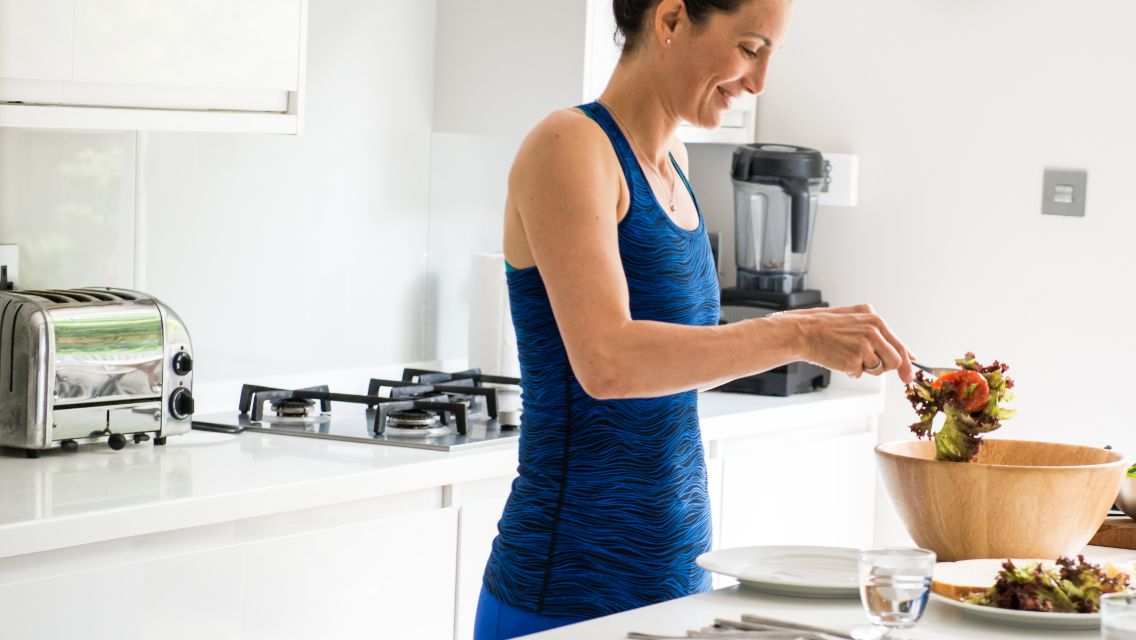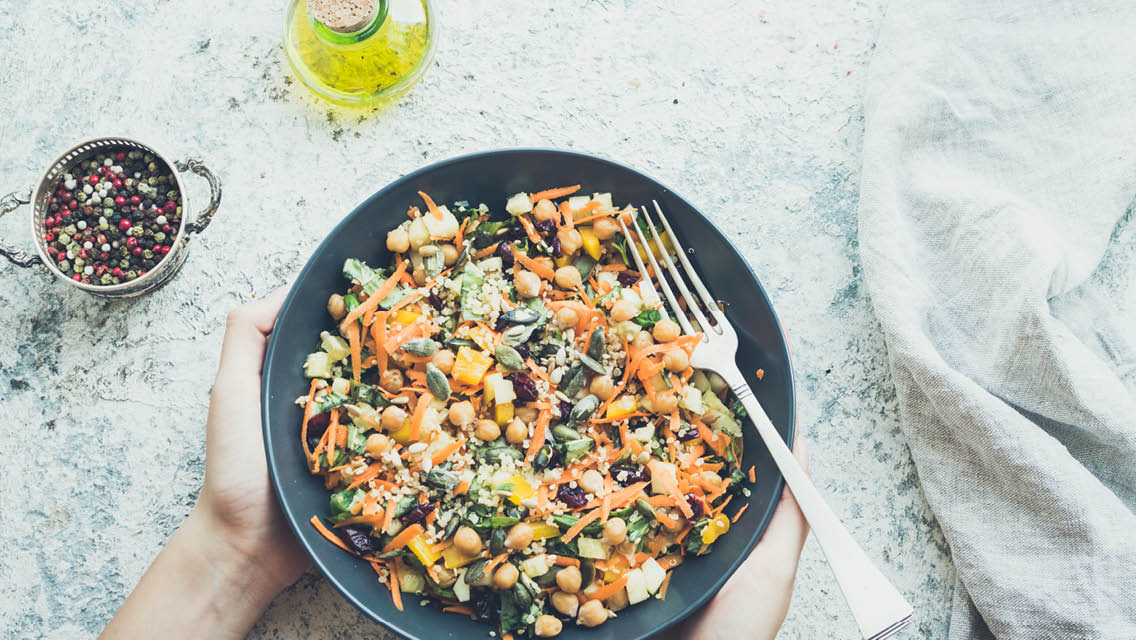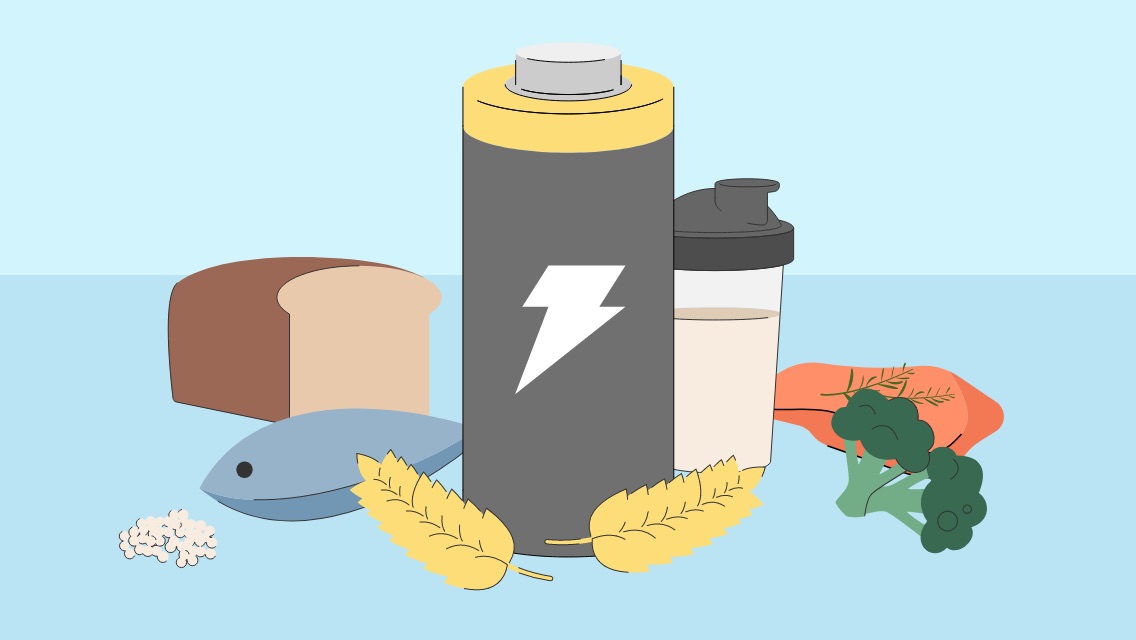The question “What should I make to eat?” comes with its own set of sub-questions: How can I be sure it’s healthy? What ingredients do I include? How can I make it taste great?
While the line of questioning may initially be overwhelming enough to make you want to forgo the effort and reach for a takeout menu, there is a simple template you can follow to ensure your meals include a balance of key nutrients, mixing and matching to guarantee variety and combat blandness.
It’s a formula that Chef Ryan Dodge, executive chef for Life Time’s LifeCafe’s nationwide, and Lindsay Ogden (a.k.a. Coach Lo), CPT, nutrition coach, and digital manager for content and coaching at Life Time, have experience with: Dodge uses it for menu creation, while Ogden shares it with clients and when developing meal guides for programs.
It’s built around four main categories: protein, vegetables, healthy fats, and complex carbohydrates. Prioritizing these food groups at mealtime ensures you get in the macronutrients and micronutrients necessary for a healthy, balanced diet.
“Ideally, you want to be getting something from each category at every meal,” says Ogden. “But keep it simple. I find clients tend to stress about recipes or exact measurements. Most people will see results from simply getting in the foods mentioned at the portions recommended.”
Dodge adds, “We ought to be thinking about nourishment when eating, not solely just eliminating hunger. When I’m thinking about crafting a meal, I’m asking, ‘What does the body need?’ ‘What’s in season?’ and ‘How can I make it satiating?’ That forms my jumping off point.”
The following template can get you started. Plus, the tips from Dodge and Ogden provide ways to use it to make meals easier and tastier.
The 4 Building Blocks
Protein
Amino acids (protein’s building blocks) produce important molecules such as enzymes, hormones, neurotransmitters, and antibodies to keep the body functioning properly. You need protein to help your body repair and make new cells, while it also stimulates the release of satiety hormones, helping to keep you feeling full.
Suggested choices: Organic and grass-fed beef; organic and pasture-raised chicken, turkey, pork, and eggs; bison; wild-caught salmon; shrimp; tuna; or organic tofu.
Amount: A serving about the size and thickness of your palm, choosing one palm-size portion for women and two for men.
Vegetables
Vegetables are power foods: They’re rich in antioxidants, vitamins, minerals, and phytonutrients, and help preserve bone mass and muscle tissue. They contain a lot of water, which supports hydration. They also deliver fiber — a critical nutrient many are low in — which among its important health benefits can also help keep you feeling full longer.
Suggested choices: Leafy greens, such as spinach, romaine, kale, or arugula; broccoli; Brussels sprouts; cauliflower; cabbage; carrots; celery; green beans; onions; bell peppers; beets; asparagus; cucumbers; mushrooms; zucchini; pumpkin; or eggplant.
Amount: A serving that fills half of your plate.
Healthy Fats
We need adequate amounts of fat to support metabolism, cell signaling, the health of body tissues, immunity, hormone production, and the absorption of several nutrients, including fat-soluble vitamins.
Suggested choices: Healthy oils, including olive, avocado, and coconut oils; avocados; grass-fed butter; ghee; olives; seeds, nuts, or nut butters, such as peanut or almond.
Amount: A serving about the size of your thumb, choosing one thumb-size portion for women and two for men.
Complex Carbohydrates
Carbohydrates are the body’s main source of energy: They help fuel the brain, kidneys, heart muscles, and central nervous system. Complex carbohydrates tend to be lower on the glycemic index than other forms, which is better for satiety, blood sugar, and body composition.
Higher amounts of carbohydrates are needed with increased physical activity and goals of muscle and lean mass gain. However, amounts may need to be watched if you’re sedentary and/or have blood-sugar concerns. (Read more: “What Is Your Unique Carbohydrate Tolerance?”)
Suggested choices: White, yellow, red, purple, or sweet potatoes; butternut or spaghetti squash; whole grains such as brown rice, quinoa, farro, or buckwheat; corn; legumes such as lentils, peas, or beans; and fruits such as berries, apples, oranges, pineapple, peaches, bananas, mangoes, cantaloupe, pears, or grapes.
Amount: A serving about the size of your fist when clenched, choosing one fist-size portion for women and two for men.
Bonus Adds
Spices
In addition to sea or Himalayan salt or black pepper, you can bring flavor and additional health benefits to dishes through spices such as garlic, curry, and chili powders, ginger, cumin, cinnamon, oregano, turmeric, Chinese five spice, cayenne, or red pepper flakes. You can even create your own seasoning blends.
Herbs
Herbs can add freshness and concentrated nutrition to meals. Consider options such as cilantro, parsley, basil, rosemary, thyme, dill, chives, or mint.
Sauces, Dips, and Toppings
Choose store-bought varieties without added sugars or refined oils, or make your own healthy options such as hummus, teriyaki sauce, tzatziki, pesto, tahini-yogurt, harissa, or chipotle red pepper, or condiments like flavored mayonnaise, spicy brown mustard, or tartar sauce.
Chef Dodge and Coach Lo’s Top Tips for Assembly
- “I typically start with the protein source, then choose a vegetable and carbohydrate that complement it,” says Ogden. “Healthy fats tend to be pretty easy to get if you do so through oils in preparation, or you can also add things like avocados or nut butters at the time of the meal.”
- “You have to have a little indulgence in your dish,” says Dodge. “I do that through adding flavor with salt, herbs, and seasonings, and satiation through cooking veggies with a pad of butter or finish of olive oil, for example. I also look for ways to sneak in subtle heat. I like to use red pepper flakes, cayenne, different chilis, or crushed garlic. Those are my keys to making things taste and pop without adding a ton of calories.”
- “In any given week, I suggest picking three proteins, three vegetables, and carbohydrates, depending on your goals, and do batch cooking,” says Ogden. “If items need to be cooked, try to get a combination of appliances running, such as the oven, stove, and/or grill, to make meal prep quicker and more efficient.”
- “I’m always trying to incorporate greens into everything I do, which is why you’ll see kale included in the Chicken Gyro Bowl, for example, and romaine in the Southwest Bowl on the LifeCafe menu,” says Dodge. “People need to eat their greens, so I’m constantly looking for ways to include those phytonutrients.”
- “Once I find a combination I like, I stick with it, switching up one thing at a time, such as the vegetable or seasoning. Once I’m bored with the combo, I mix it up again,” says Ogden. “Some go-to combinations for me include ground turkey with spinach, rice, and coconut curry; chicken with peppers, avocado, and quinoa; or a beef patty with Brussels sprouts and sweet potato mash.”
While this approach will work for most people, we recommend connecting with a nutrition coach or registered dietitian for a more tailored plan if you have specific fitness goals or health or dietary needs.





